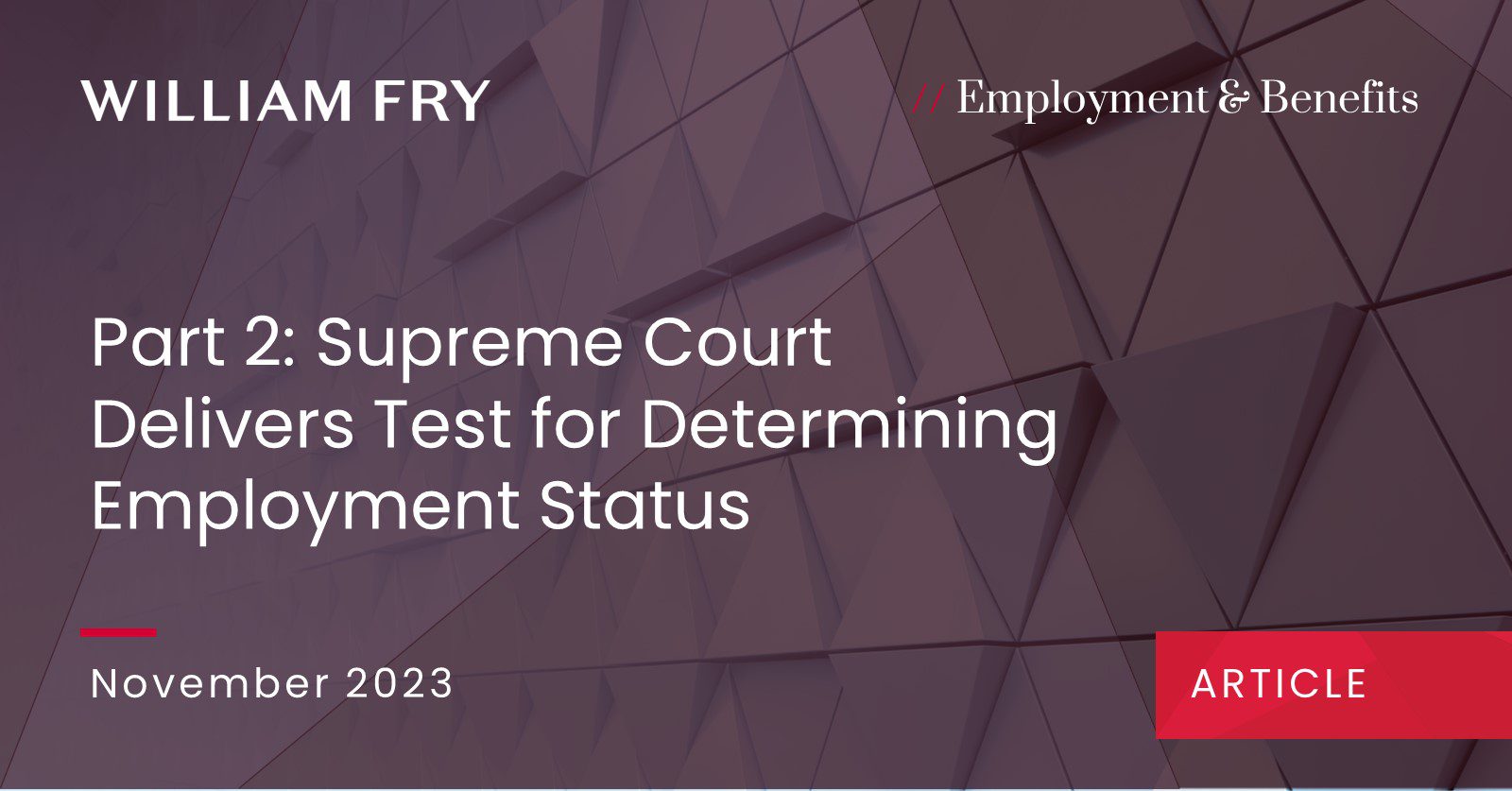In this Part 2 of our two-part series on the judgment in The Revenue Commissioners v Karshan Midlands Ltd t/a Dominos Pizza [2023] IESC 2, we examine the five questions posed in the judgment of Murray J and look at how these questions were answered on the facts of this case.
The analysis of the Supreme Court offers useful guidance for anyone engaging workers in Ireland to classify their workers correctly and, in turn, may help to avoid the legal and tax consequences of misclassifying the contractual relationship.
Background
In Part 1 of this series, we discussed the landmark decision of the Supreme Court in The Revenue Commissioners v Karshan Midlands Ltd t/a Dominos Pizza [2023] IESC 24.
In short, the respondent, Karshan Limited (Karshan), argued that delivery drivers were independent contractors, whereas the appellant, the Revenue Commissioners, argued these workers were, in fact, employees.
The Supreme Court held that delivery drivers were to be treated as employees and not independent contractors for the purpose of the Taxes Consolidation Act 1997 (the Act). In delivering a unanimous judgment for the Supreme Court, Murray J set out five questions to be considered when seeking to determine whether a worker is an employee engaged under a contract of service or whether they are an independent contractor engaged under a contract for service.
The Five Questions
When seeking to determine if a contract is one of service (i.e. an employment relationship) or a contract for service (i.e. an independent contractor arrangement), the Supreme Court held that this determination should be resolved by having regard to established case law and to five questions.
These five questions have been set out below, along with an overview of how the Supreme Court answered these questions on the facts of this case.
The first three questions are to be viewed as a filter; if any of them is answered negatively, there cannot be a contract of employment. If the first three questions are answered affirmatively, questions four and five must then be considered to determine if a contract of employment exists.
1. Does the contract involve the exchange of wages or other remuneration for work?
The Supreme Court held that there were binding legal relations between Karshan and the delivery drivers that involved the exchange of consideration in return for labour. This is characteristic of an employment agreement.
2. If so, is the agreement one pursuant to which the worker is agreeing to provide their own services, and not those of a third party, to the employer?
The second characteristic that is looked at in determining employment or self-employed status is that of ‘substitution’. This involves an analysis of (a) whether the worker is allowed to send a substitute to do the work in the event they are unable to do it, and (b) if substitution is allowed, asking who engages and pays the substitute.
Karshan’s contracts with the delivery drivers contained a substitution clause that allowed a delivery driver a right of substitution when they had been rostered to work but were unavailable to work at short notice. However, this right was limited, as:
- the replacement driver had to be someone who was engaged as a driver by Karshan; and
- the replacement driver, and not the driver originally rostered, would be paid for the work.
The Supreme Court held this arrangement did not amount to an unqualified power to delegate but was an arrangement more akin to the swapping of shifts between drivers. On this basis, the drivers were deemed to be providing their own services to Karshan.
3. If so, does the employer exercise sufficient control over the worker to render the agreement one that is capable of being an employment agreement?
Control is an important factor in helping to determine employment status. This involves an examination of whether the person engaging the worker has the right to direct the worker on what is to be done, as well as how, when, and where it should be done.
There were numerous factors in this case that confirmed Karshan exercised the necessary control over their drivers. Firstly, Karshan set the rosters and was responsible for the weekly allocation of work. They controlled how drivers dressed, the times at which drivers had to present themselves, the number and extent of the deliveries to be made, and particularities related to insurance.
In addition, the drivers had ongoing obligations during the week in which they were rostered for deliveries to prepare and create weekly invoices, which the local branch was also involved in preparing and filling out. There was also evidence that delivery drivers were directed to make up pizza boxes when at the premises, and a failure to comply with this requirement could result in the manager sending the driver home for the remainder of the shift.
All of these factors pointed to a high level of control by Karshan over the delivery drivers, which was indicative of an employment relationship.
4. If these three requirements are met, the decision maker must then determine whether the terms of the contract between the employer and worker, interpreted in the light of the admissible factual matrix and having regard to the working arrangements between the parties as disclosed by the evidence, are consistent with a contract of employment, or with some other form of contract having regard, in particular, to whether the arrangements point to the putative employee working for themselves or the putative employer.
As the first three questions on remuneration, substitution, and control were answered affirmatively, the Court then proceeded to look at the entire factual matrix of the engagement.
Firstly, the Court examined whether the drivers could be viewed as carrying on business on their own account.
On the facts, the delivery drivers were not viewed as conducting business on their own account because they did not answer calls from customers, they didn’t employ (or have the right to employ) workers to undertake the deliveries, and they worked exclusively from Karshan’s premises. In addition, the drivers did not take any economic risk, their ability to maximise profits was limited by the control exercised by the on-site managers, they did not scale their delivery business to a particular market, and they did not advertise their services.
While the drivers funded their own insurance and used their own vehicles and mobile phones, this was outweighed by other factors which pointed to an employment relationship. The drivers’ work ‘was in every sense work for Karshan’ and directed towards advancing Karshan’s business rather than that of the drivers.
The Court also examined the contractual arrangement in place. Karshan had argued that the agreements were more casual in nature, and that the employees assumed the risk that they could turn up to work but receive no pay. The Court disagreed and held that from the moment the drivers agreed to go on the roster, there was an obligation on Karshan to pay them for that period, and to allow them the opportunity to work.
Karshan had also argued that there was no binding obligation on the drivers to show up once rostered and that drivers were free to come and go during their shifts. Again, the Court disagreed and concluded that:
- the contract obliged drivers to notify Karshan if they were unavailable for a shift. The purpose of this was to ensure Karshan had enough drivers working a shift. This could never be guaranteed if the drivers were allowed to come and go as they wished; and
- if there was no obligation on the driver to turn up, then they would simply not turn up and there was no need to include a substitution clause in the contract to allow them to nominate a substitute.
Taking the broad factual matrix into account, the Supreme Court held that the delivery drivers engaged by Karshan were employees.
5. Finally, it should be determined whether there is anything in the particular legislative regime under consideration that requires the court to adjust or supplement any of the foregoing
The Court noted that generally, when the Oireachtas refers to an ’employee’ or ‘contract of service’ it is referring to an agreement that contains the key features as determined by common law.
However, the Court did warn that it may be ‘easy to overlook‘ that ascertaining the meaning of a phrase such as ‘employee’ or ‘contract of service‘ appearing in legislation will involve an exercise in statutory construction like any other. There may be legislation in which certain words or phrases are intended to have a different meaning. Although the consideration of underlying legislation was not relevant in this particular case, it may be an important consideration in a future case.
Conclusion
Incorrect classification of workers could lead to adverse legal and tax consequences. Anyone engaging workers in Ireland should refer to the five questions above and use the Supreme Court’s analysis as a guide to help classify the contractual relationships with their workers.
Contributed by Elaine Egan


